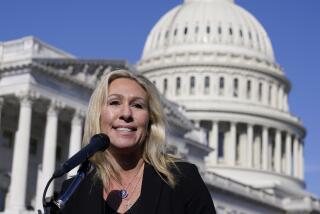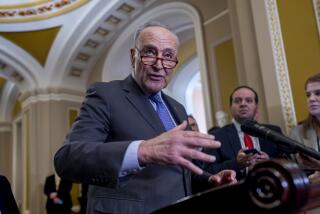Congress OKs $100-Billion Education Bill
WASHINGTON — The House gave final congressional approval Wednesday to a $100-billion five-year higher education bill intended to make it easier for all college students--including those from middle-income and wealthier families--to finance their own schooling.
President Bush is expected to sign the bill, a compromise worked out among Democratic and Republican lawmakers, despite his misgivings about provisions for direct federal loans for college tuition and expenses.
“This shows that government gridlock can be broken,” said Rep. E. Thomas Coleman (R-Mo.), a key negotiator of the compromise. “What we have is a bill that puts the public interest first.” The House vote was 419 to 7. The Senate approved the compromise last week.
Democratic and Republican lawmakers rushed to back the election-year package. The legislation provides new benefits for hard-pressed middle-class families who generally have been denied scholarships, grants or even federally guaranteed student loans because of income limits on existing programs.
“I’m glad to see middle-income families get some attention at last,” said House Minority Leader Robert H. Michel (R-Ill.), voicing a common theme.
The measure spells out financial aid rules for the next five years. But Congress still must appropriate funding before the increases in college aid will occur, and budget austerity pressures may delay full funding, congressional aides predicted.
If appropriations are provided at the authorized level, however, sponsors said that about 1 million more middle-income students will be eligible for federal Pell grants in the first year of the new program. Another 1.4 million students would become eligible for guaranteed loans, with 86% of them from middle-income families.
Key provisions of the bill would:
* Allow students of any income level to borrow from the federal government at a 9% rate, provided they immediately begin repaying the loans. The rate is several points below commercial rates on loans for the same purpose.
* Ease the terms of the government’s subsidized loan program for students with limited means. Under the new terms, equity in homes and farms will no longer be included as family income in eligibility calculations.
* Increase to $70,000 the maximum income a family of four can earn and still be eligible for the subsidized loan program.
* Increase the maximum size of Pell grants from $3,100 to $3,700, and increase from $35,000 to $42,000 the ceiling on income for a family of four to be eligible for the smallest Pell grants.
* Create a pilot program in which the government will make direct student loans, without banks or other middlemen. Thirty-five percent of these loans--which may total as much as $500 million in the program’s first year--would be repaid on a schedule tied to the student’s income.
The direct-loan experiment had brought strong opposition from the banking industry. But the General Accounting Office estimated that the government could save as much as $1.5 billion a year if it made the loans directly.
The legislation calls for the Department of Education to set up the apparatus for administering the direct-loan program. Its first step would be to invite colleges and universities to apply to participate.
Advocates of higher federal spending noted that the bill’s provisions for more generous funding would not fully make up for the erosion of federal aid that has taken place in recent years.
For example, because of inflation, the maximum Pell grant shrank by 18% over the last decade, said David Merkowitz, a spokesman for the American Council of Education.
More to Read
Get the L.A. Times Politics newsletter
Deeply reported insights into legislation, politics and policy from Sacramento, Washington and beyond. In your inbox three times per week.
You may occasionally receive promotional content from the Los Angeles Times.











